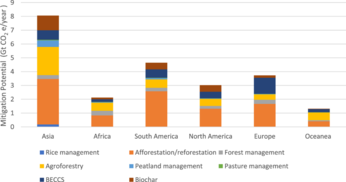
In a world facing the pressing issue of climate change, land-based mitigation technologies and practices (LMTs) have emerged as an important tool in our efforts to combat global warming and stay on course with the goals set by the Paris Agreement. A recent study conducted by Karki et al. (2023) in collaboration with Bioclear earth as part of the LANDMARC project (2020-2024) sheds light on the potential and barriers associated with these LMTs. This article provides a basic overview of their findings, published in Environmental Research Letters under the title "Potentials and barriers to land-based mitigation technologies and practices (LMTs)-a review".
LMTs are strategies that involve using our land resources to help reduce the harmful effects of climate change. The Paris Agreement, a global initiative, aims to keep the planet's temperature rise within safe limits. To achieve this, it is vital to find ways to manage our land wisely and make it part of the solution.


Mitigation potential of LMTs in different regions, Gt CO2 e year−1.
Despite their potential, there are challenges to implementing LMTs. Lack of knowledge about how to put these strategies into practice and inadequate funding are the main obstacles to their widespread use.
It's important to remember that not everyone is equally affected by climate change or has access to LMTs. Neglecting the rights and needs of marginalised groups and indigenous peoples can exacerbate existing inequalities. Therefore, it is crucial to consider the social and institutional implications of LMTs to ensure that they benefit everyone and don't harm vulnerable communities.
Achieving our ambitious climate goals while also meeting other important social and environmental objectives requires an integrated approach. This means not only reducing carbon emissions, but also taking care of people's well-being and protecting our planet's ecosystems.
In our fight against climate change, land-based mitigation technologies and practices offer hope and potential. The study by Karki and his team underlines the importance of these strategies. But it also highlights the challenges we must overcome, from knowledge gaps to financing issues and the need to address social inequalities.
To succeed in our mission to protect the planet and future generations, we must take a holistic approach that balances our climate goals with the well-being of all people and the preservation of our natural world. By working together and understanding the complexity of LMTs, we can make significant progress towards a more sustainable and climate-resilient future.
